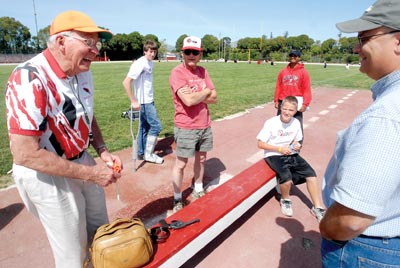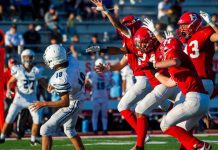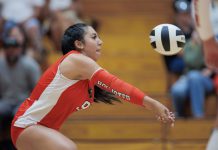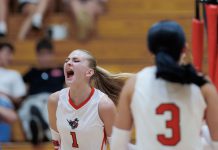
After stepping down as head coach of the San Benito High track
and field team in 1970, Hollister resident Allen Dunn became the
high school team’s starter, and he’s been doing it ever since
HOLLISTER
It could have happened last week during San Benito’s track meet against North Salinas, or it could have happened about 40 years ago. The episode between coach and athlete that Allen Dunn can recall on a whim could have happened at any point in between.
“I remember one young lady who was a hurdler. And she was doing well but she would hurdle standing up,” said Dunn, a Hollister resident who has been the track starter for, more or less, every one of San Benito’s track and field meets at Andy Hardin Stadium for the last 40 years.
“I said, ‘Lean forward over the hurdle,'” he recalled. “When you lean forward, your rear-end comes up and you get closer to the hurdle.
“You don’t jump up over the hurdle, you jump forward.”
It’s a common scene that has played itself out somewhere on the stadium’s infield ever since Dunn moved to Hollister from Grizzly Flat near Placerville in 1956 — the track-coach-turned-track-starter doling out tips and advice and coaching points to any track athlete that might listen, whether “Balers” is emblazoned across their chest or not.
The scene of Dunn providing pointers to an otherwise unsuspecting hurdler has happened for as long as anyone can remember.
“I still do a little coaching along the side,” Dunn said. “But predominantly, they’re Hollister kids.”
Many in San Benito County may only know Dunn as a track and field starter, though, as the 77-year-old, along with his trusty .45 caliber pistol, have become synonymous not only with track and field meets at San Benito High, but also with local competitions within the neighboring area.
He’s been a starter at the Avis Kelley Invitational in Gilroy and the Bill Kearney Invitational in Salinas, among other meets up and down the Central Coast, and has been the starter at all of San Benito’s home meets since 1970, when he officially stepped down as the high school’s track and field coach after about 13 years.
“I’ve been doing all the starting, or at least I think I’ve been doing all the starting,” he said.
It’s not at all unusual for would-be strangers, whose sons and daughters are now competing for the Baler track team, to remember Dunn as the starter when they were going to high school in Hollister.
And it’s not at all unusual for Dunn, after a brief conversation, to recall the names of those would-be strangers, either.
“He’s been a fixture for many years,” said Randy Logue, who coached the track and field program at San Benito High on and off for about 16 years, and recalled Dunn’s nickname — “The Cannon.”
Current boys head coach Iran White remembers his track-running days at San Benito High, too, and remembers Dunn right along with it.
“Allen, he was there starting when I was running there,” White said. “I get some good (coaching) tips from him still. He’ll see the kids run and point something out. He’s a tremendous asset.”
Added Logue, “He’s a living legend in the town of Hollister.”
‘Track was natural for me’
Dunn’s life as a track-and-field cowboy — his .45, which was manufactured in the 1930s, is holstered to his hip in between races — is only part of the track addict’s background.
Born in Placerville, Dunn was raised in Grizzly Flat where his father was a surveyor. Located on the outskirts of Eldorado National Forest, Grizzly Flat offered more than enough land for Dunn and his childhood friends to run around, including caves, tunnels, relics, even irrigation ditches from the nearby American River.
“We didn’t have baby-sitters,” Dunn said. “When I was in fourth, fifth, sixth, seventh, eighth grade, we’d just run around the country.
“Track was natural for me. I enjoyed running.”
The sport itself didn’t come along until Dunn was 15 and a sophomore at El Dorado High in Placerville, and by most standards, it still wasn’t all that attractive. Without anything that could pass for a track nowadays, El Dorado High, which had a football field and a baseball diamond, instead created a chalk line around both grass fields to represent the track — “Nothing fancy,” Dunn said.
The meager standards had little effect on Dunn, though. It was running, whether it was held on a proper track or not, and that’s really all that mattered.
Competing in the mile and the 880 almost exclusively from a sophomore on through high school, Dunn was relatively new to the sport, but still managed to qualify to the state meet three years in a row — a feat he didn’t consider a “big deal” at the time. He even ran a 4:26 mile during his senior year, which was considered the fifth fastest in the nation.
“In those days,” he said, “that was pretty good.”
While later running at San Jose State, Dunn’s time in the mile while attending Modesto Junior College is what still stands out in his mind. During the same period when Roger Bannister was vying to break the 4-minute mile, Dunn’s fastest time ever recorded was a 4:10, but it was the 4:13 he clocked one year that only further ingrained his love for the sport.
In a collegiate race against one other harrier, Dunn and his fellow competitor recorded a somewhat slow split time of 73 seconds on the first lap, leading one onlooker to question whether they were jogging the two-mile.
The criticism set Dunn off, though, and he completed the mile race in 4:13, or three minutes even for the last three laps.
“If you can put four laps together on that pace, you’ve got a 4-minute mile,” Dunn said. “It wasn’t record breaking or anything. But it was a race that said you can do just about anything that you decide to do.”
‘Being track coach filled the void’
Although his career as an athlete slowed following graduation from San Jose State in 1954 — the same year Bannister broke the 4-minute mile mark — Dunn never strayed far from the track. Initially taking a job as a math teacher at San Benito High in 1956, Dunn became the assistant track coach in 1957, and later the head coach in 1960.
“Being track coach filled the void,” said Dunn, who was unable to continue competing in track as work and family life took over. “But no regrets.”
Dunn’s head coaching stint lasted about 10 years, and he helped pioneer the first girls track and field team at the high school and the first cross country team at the high school, and he was even instrumental in the design of the current track at Andy Hardin Stadium.
But it’s his life as a starter that has made Dunn even more recognizable in recent years, and it’s not necessarily because of the hunting orange cap he wears while out on the oval.
Dunn has starting down to a science. He loads his own shells, makes his own reloading dies, and knows exactly how much sound, smoke and spark are necessary for proper starting purposes — the most important thing about starting being the smoke, he said.
After all, he’s been doing it for a little more than 40 years, so he has plenty of experience.
“I load it with black powder, and it’s the only way I can get a decent amount of smoke out on the track,” said Dunn, noting how the smoke, and not the sound, supplies a much-needed aid for the timers.
“If we can afford an electronic timing system, I could a use a .22 and the kids would be happier because it’d be less noise.”
Track has essentially been at the forefront of Dunn’s life ever since he was 15, but the sport did take a backseat recently.
In perhaps his only year off from the job, Dunn battled lung cancer last season and underwent chemotherapy treatments as a result before doctors had to remove the left side of his lung. More recently, he has suffered knee problems and is uncertain as to whether he’ll be trackside for spring meets in 2011.
He’s contemplated giving up the gig that’s allowed him to stay on track all these years, a job that has made him one of the most reliable, professional and dependable starters in the area, Logue said.
Of course, if he can’t, he said he wouldn’t mind taking over the announcers booth — anything to stay trackside and keep passing out pointers.
“Previously, I’d go anywhere to start a track meet for anyone who wanted me to start,” Dunn said. “Track is a way of life, and I don’t mind doing it as long as I can do it.”









